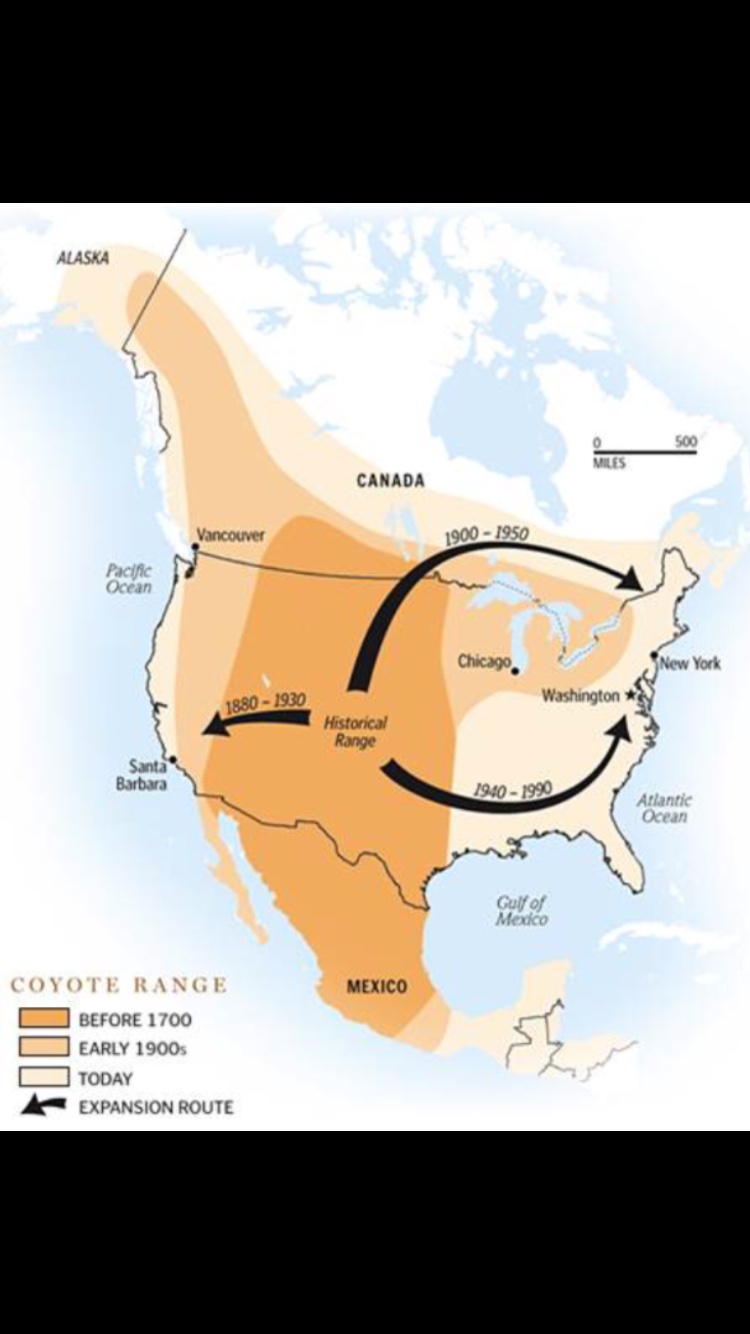dogghr
Well-Known Member
That's some interesting info and map you show Tex. Hadn't seen how govnt worked to eradicate the predators with decent success except for the wily coyote. Also interesting how the map shows the migration of the coyote which in my mind corresponds to the heavy logging of the East in the first half of last century which made dramatic changes in the makeup of the eastern forests and its inhabitants.Interesting thread, thanks dogghr. Ever since I spotted the first coyotes on our property I started looking more and more into ways of hunting and trapping them. But the more I research the more I find that efforts to get rid of them seem to be counterproductive in the long run. Historically speaking we in America have been very successful at eradicating numerous species. Gray wolves, grizzlies, bison, and others were almost completely eliminated from the lower 48. Even white tailed deer numbers dropped precipitously. Only through conservation efforts in recent decades have these animals started to make a comeback. But the coyote is a completely different story. Following the eradication of the gray wolf at the turn of the twentieth century, efforts turned to the elimination of the coyote. But despite almost a century of pressure, coyote numbers have gone up, not down. Formerly their range was limited to an area west of the Mississippi. Now they are found in every state except Hawaii.

As you can see from the map, they don't just survive under pressure, they thrive. Even with the encouragement of federal, state and local governments in the early 1900s, their range expanded as the pressure increased. In Montana, for example, around the turn of the century the government offered a bounty on wolves and coyotes. Over the course of about a decade, the wolf bounties went from over 20,000 down to about 17. Coyote harvests on the other hand stayed right around 30,000 for three decades. In the 1940s the US government developed new poisons to use specifically on coyotes because strychnine no longer worked. The problem was that strychnine killed them too quickly. If one coyote noticed another coyote dying after eating bait with strychnine, it learned to avoid it and taught its offspring to do the same. So three new poisons were developed, designed to kill them over the course of a week or two. As you can see from the map above, that didn't work out too well either.
So why were we able to eliminate wolves so efficiently but we can't seem to control coyote populations? I've heard some interesting theories on this and of course there's still some ongoing studies. But it seems like they have some impressive reproductive strategies. One theory is that when they do their howling at night, they are doing a role call. If one coyote fails to report for the role call, some how dominant females will then have larger litters the next go round. Whatever the mechanism, it seems like the more you kill, an even greater number will eventually come back. And this new population will tend to skew younger, and like human youngsters coyote youngsters tend to be more aggressive and less averse to taking risks.
So what's a habitat manager to do? I think you might be on the right track dogghr, we just might have to learn to accept them as a part of the environment. If one is bold enough to show itself I'll take a shot at it, but I've decided for my little property any serious effort at hunting and trapping would be fruitless and maybe make things worse. But I do like Swampcat's idea about creating better habitat for the coyotes preferred prey, namely rodents. Maybe if they can keep their stomach full on those then fawns might stand a better chance. Maybe a stretch, but from the evidence it looks like the yotes ain't going away any time soon.
And as for the howling or yapping of yotes, I've seen they reduce the amount they do when being actively hunted or trapped.
Many on here may not remember the cartoon the Road Runner. I watched it all the time and it was about Wil E. Coyote as he repeatedly tried to catch the fast running ground bird, the Road Runner. Never would have thot years later I would become so obsessed with all the Wil E's of the world.
I would agree with that but I know one 5 year study showed only one turkey taken by yotes. Not so sure my area doesn't see more predation on them than that.I’m not overrun with yotes, but reading about fawn survival makes me wonder what’s going on at my place. It’s uncommon to see a doe without 2 or 3 fawns in the fall. However, there’s very few coons, rabbits, groundhogs etc.
my best guess is that the turkeys are keeping the yotes fed. It’s a common sight to drive by a cut corn field near my property and see 50-80 turkeys out there. Perhaps the yotes around me have adapted to hunt down the turkeys in April-June. Think about it, every time they gobble they’re telling everything in the woods where they are. It shouldn’t be hard for a yote to ambush them.
Sent from my iPhone using Deer Hunter Forum
Thanks for all the responses and hope it gives you some thinking as how to fight the problem in real and less frustrating methods. And thanks for keeping it civil. Wasn't quite that way on the old forum when I discussed it. I appreciate it.
I'll let the conversation continue for another week or so before we tackle another major player... the bear.
